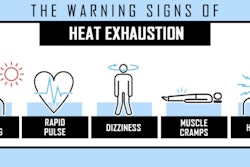July and August are traditionally some of the hottest months of the year, and this year seems to be on pace to set new records across many parts of the country. Keeping crews safe under such extreme conditions is imperative.
“Heat-related illnesses can be fatal, and employers are responsible for keeping workers safe,” says U.S. Secretary of Labor Thomas E. Perez. (OSHA issued 11 heat-related citations last year.) “Employers can take a few easy steps to save lives, including scheduling frequent water breaks, providing shade and allowing ample time to rest.”
To raise awareness of heat-related risks, the Occupational Safety & Health Administration (OSHA) announced in May the launch of its annual Campaign to Prevent Heat Illness in Outdoor Workers. This campaign aims to raise awareness and educate workers and employers about the dangers of working in hot weather, as well as provide resources and guidance to address these hazards.
OSHA has developed heat illness educational materials and curriculum in both English and Spanish for workplace training. In addition, a web page (http://1.usa.gov/Soje2I) has been established to provide information and resources for workers and employers on heat illness, including how to prevent it and what to do in case of an emergency.
OSHA also released a free app for mobile devices that enables workers and supervisors to monitor the heat index at their jobsites. The app displays a risk level for workers based on the heat index, as well as reminders about protective measures that should be taken at that risk level. It can be downloaded by visiting http://1.usa.gov/1ig612y.
You can find additional information to prevent heat-related illness on our website at ForConstructionPros.com. For example, John J. Meola, CSP, ARM, a safety consultant with Invincia Insurance Solutions, offers his advice to keep your cool in the article “12 Tips to Survive Another ‘Nuclear Summer’” (ForConstructionPros.com/11527421). Here’s a quick look at some of his recommendations:
- Stay hydrated. Plan to make water easy to reach and keep it at a cool, drinkable temperature. Provide electrolyte replacement beverages. Avoid soda pop and energy drinks.
- Eat right. Avoid high-fat, greasy fast food. Try to eat a lighter meal during the hottest time of day.
- Timing is everything. Whenever possible, plan the job to avoid direct sun or move up the start time. If working in direct sun can’t be avoided, schedule frequent rest breaks in a shaded area.
- Dress to stay cool. Engineered fabric athletic and recreational garments can reduce the heat load on the body. They offer trans-evaporative cooling, plus UV and insect protection.
- Avoid going in and out of air conditioned climates. That’s a body slam each way in terms of adjusting.
- Cool it down. The neck and head pretty much govern the heat loading on the body, because a lot of blood flows through these parts. Cooling “bandanas” and similar devices can be effective to remove some caloric energy from your circulatory piping.
- Be alert for signs of heat stress. The order of seriousness is: 1. Heat cramps — Usually from poor hydration; take it easy, drink water, put feet up. 2. Heat exhaustion — Knock off for the day, go someplace cool, rehydrate, rest. 3. Heat stroke — Call 911.
Working outside in challenging conditions is par for the course in this industry. Yet, it doesn’t have to be life threatening as long as you stay informed and take the appropriate precautions.






![[VIDEO] Heat Illness Daily Checklist](https://img.forconstructionpros.com/files/base/acbm/fcp/image/2016/06/default.574ee85aee173.png?auto=format%2Ccompress&fit=crop&h=167&q=70&w=250)
![[VIDEO] How to Prevent Heat Illness](https://img.forconstructionpros.com/files/base/acbm/fcp/image/2016/06/default.574ee7fe1bbca.png?auto=format%2Ccompress&fit=crop&h=167&q=70&w=250)
![[VIDEO] Responding to Heat Illness](https://img.forconstructionpros.com/files/base/acbm/fcp/image/2016/06/default.574ee79b691eb.png?auto=format%2Ccompress&fit=crop&h=167&q=70&w=250)











